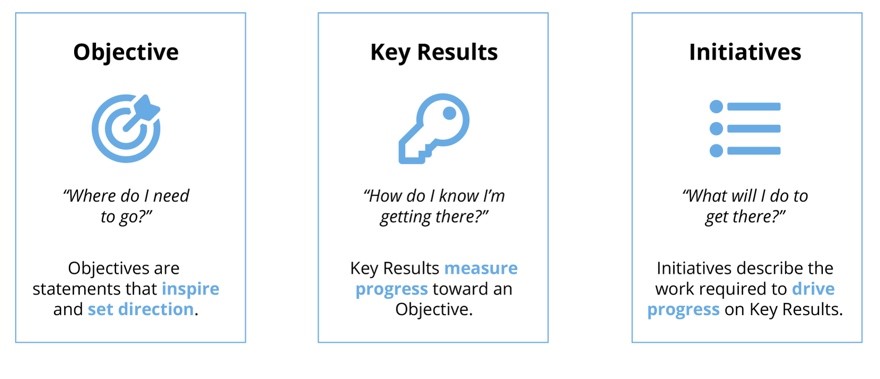Part 3 of our Unlocking Outhouse’s Potential with OKRs series

In our journey so far, we’ve explored why OKRs are valuable and how to prepare your organization for this powerful framework. Now, it’s time to roll up our sleeves and dive into the art of crafting OKRs that truly drive results. In this post, we’ll focus on what makes for an effective Objective and Key Result, ensuring they align with your company’s broader goals.
Characteristics of Effective Objectives
An Objective is a concise statement that outlines a broad, qualitative goal designed to propel your organization forward. For those new to OKRs, the challenge often lies in understanding what makes a good Objective. Let’s break it down:
Inspirational
A well-crafted Objective is more than just a collection of words describing a business goal. It should compel your team to strive for a higher standard of performance. The power of an Objective lies in its ability to challenge your team to think differently. For example, instead of aiming for a modest 10% improvement, an Objective that pushes for a 50% increase will force your team to solve tough problems and rethink their approach. That’s the essence of what OKRs are meant to achieve.
Qualitative
Objectives should represent what you hope to accomplish, expressed in words rather than numbers. While numbers are crucial, they belong in your Key Results. The Objective is about setting the direction and the ambition, not the metrics.
Attainable
Striking the right balance between inspiration and reality is crucial when crafting Objectives. While it’s important to push the limits of what your team believes is possible, you also need to be realistic. Encouraging your team to stretch their imaginations is key but remember that every Objective should still be within reach with the right effort.
Doable in a Quarter
Assuming you’re setting Objectives on a quarterly basis, they need to be achievable within that three-month period. If your team suspects that an Objective will take a year to accomplish, then it’s probably closer to a strategy or vision than a quarterly goal.
Controllable by the Team
Whoever drafts the Objective, whether it’s at the corporate, department, team, or individual level, must be able to control the outcome. If your Objective isn’t met by the end of the quarter, and your first thought is to blame external factors like “Sales didn’t deliver,” then you’re missing the spirit of OKRs. The Objective should be something your team can directly influence.
Provide Business Value
Your Objectives should be directly tied to your strategy and should create tangible value for the business if achieved. If there’s no clear business benefit at the end of the day, then it’s probably not worth the effort.

Tips for Creating Great Objectives
Avoid the Status Quo
When setting Objectives, aim to push the boundaries of what your team can achieve. Avoid Objectives that simply recite what you’re already doing, like “Maintain market share” or “Keep training employees.” If you can accomplish an Objective without changing how you work, it’s unlikely to drive significant progress.
Use Clarifying Questions
Sometimes, the best way to get to the heart of an Objective is by asking simple, clarifying questions. For example, if someone suggests that you should “Create value for our customers,” dig deeper. What do they mean by “value”? Are they referring to a specific segment of customers, or all customers? Escalating from abstractions to specifics will help you identify the true Objective that needs focus.
Frame Objectives in Positive Language
Your Objectives should be framed in a way that motivates and compels your team to take action. For instance, instead of saying “Reduce the amount of junk food I eat,” you might frame the Objective as “Eat more calories from healthy food.” The latter encourages proactive behavior and has a higher likelihood of success.
Start with a Verb
Every Objective should start with a strong action verb that drives the intended direction. Do you want to “maximize loyalty,” “build loyalty,” or “leverage loyalty”? The choice of verb shapes the actions that follow, so it’s essential to be deliberate in your wording.
Identify What’s Holding You Back
A powerful way to create meaningful Objectives is to identify the barriers that are preventing your team from executing your strategy effectively. What challenges are holding you back? Taking an unvarnished look at these obstacles can help you set Objectives that address critical issues and drive progress.
Use Plain Language
While it’s important to be precise, your Objectives should be written in plain language that everyone in the organization can understand. Avoid jargon and acronyms whenever possible, or if you must use them, ensure that everyone knows what they mean. Clear communication is key to ensuring everyone is aligned and understands the importance of the Objective.

Characteristics of Effective
Key Results
If Objectives set the direction, Key Results are the benchmarks that measure your progress along the way. They answer the question, “How will we know if we’ve met our Objective?” While it might seem straightforward, creating effective Key Results that accurately gauge progress can be challenging. Here’s what to keep in mind:
Challenging
Research has shown that setting high goals leads to better performance and greater satisfaction at work. When drafting Key Results, aim high. Challenge your team to push their limits and think differently. However, ensure that the goals are still within reach, so your team stays motivated to achieve them.
Measurable
Key Results should always be qualitative and measurable. Whether it’s a raw number, a dollar amount, or a percentage, your Key Results need to be tied to clear metrics. Progress should never be a matter of opinion—numbers provide the clarity needed to gauge success.
Specific
When writing Key Results, clarity is crucial. Ensure that everyone involved understands exactly what the Key Result means and what success looks like. This shared understanding prevents miscommunication and ensures that everyone is working towards the same goal.
Owned
Those responsible for delivering Key Results should be actively involved in their creation. When team members help shape the Key Results, they’re more likely to be committed to achieving them. Ownership drives accountability and engagement.
Progress-Based
According to Harvard Professor Teresa Amabile, the most important factor in boosting motivation and creativity is making progress in meaningful work. Your Key Results should reflect this principle, allowing your team to see and celebrate progress as they work towards the Objective.
Vertically and Horizontally Aligned
Your Key Results should align both vertically with your team’s broader goals and horizontally with the objectives of other teams. Regularly reviewing and sharing Key Results ensures alignment across the organization, fostering collaboration and coherence.
Drive the Right Behavior
The saying “You get what you measure” holds true. Once you focus on a specific metric, you’re naturally drawn to improving it. Think carefully about the behaviors each Key Result might encourage and ensure they align with your broader objectives.

Tips for Creating Key Results
Focus on the Key, Not All Results
This exercise isn’t about listing every possible outcome—it’s about identifying the most critical results that will drive progress on your Objective. Focus on what truly matters and avoid the temptation to track every potential action.
Describe Results, Not Tasks
Key Results should focus on outcomes, not activities. For example, “Add twenty-five qualified opportunities to the pipeline” is a Key Result, while “Email a prospect” is a task. The former measures progress, while the latter is just one step along the way. Focus on the results that signify true progress.
Use Positive Language
Just as with Objectives, framing your Key Results positively can have a powerful impact. For example, instead of “Lower error rate to 10%,” try “Increase accuracy to 90%.” The positive framing can boost motivation and commitment.
Keep Them Simple and Clear
While Key Results should be robust, they should also be easy to understand. Complexity can lead to confusion and misalignment, so keep your Key Results straightforward.
Assign an Owner
Key Results need a clear owner—someone who is accountable for their achievement. Without an owner, responsibility can become diffused, leading to inaction. Make sure someone is clearly responsible for driving each Key Result to completion.
By following these principles and tips, you’ll be well on your way to crafting OKRs that not only inspire your team but also drive meaningful progress. Remember, the power of OKRs lies in their ability to align your organization’s efforts, ensuring that everyone is working towards the same ambitious goals.
Next up… Crafting Great OKRs – Part 2.

Bill Gelbaugh is one of our Senior Partners here at Outhouse and champions our OKR efforts.